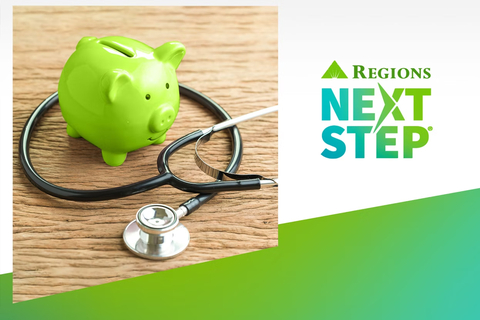Regions Next Step financial wellness program offers no-cost tools to help people navigating medical financial hardship
Regions Bank on Tuesday announced the results of a new medical financial hardship survey that finds people are not financially prepared to cover medical expenses or pay off medical debt, despite perhaps thinking they are prepared.
This press release features multimedia. View the full release here: https://www.businesswire.com/news/home/20221129005180/en/

Regions Bank on Tuesday announced the results of a new medical financial hardship survey that finds people are not financially prepared to cover medical expenses or pay off medical debt, despite perhaps thinking they are prepared. (Graphic: Business Wire)
The survey was conducted by Regions Next Step, the bank’s no-cost financial education program that serves people of all ages, regardless of whether they bank with Regions. According to the survey, six in 10 (59%) people are confident they could cover regular and expected medical costs like co-pays and deductibles. Nearly the same number (56%) feel similarly about unexpected medical costs like out-of-network charges and prescriptions.
Despite this, the survey finds many people are not able to cover medical bills when they are due. Two in five people have experienced an unexpected medical event in the last year and, among those, seven in 10 found it difficult to pay for it. Younger respondents were among the most likely to have trouble paying.
Additionally, more than one in three people (35%) have medical debt, and an overwhelming majority (82%) are struggling to resolve it. Among those with medical debt, seven in 10 respondents had debt that is either overdue or in collections. Women and those with household incomes lower than $100,000 were most likely to carry this debt, according to the survey.
Further, medical expenses and debt are taking a toll on peoples’ savings. Due to the cost of medical bills in the last year, nearly one-quarter of Americans has either used all their savings to cover the expenses or has been contacted by a collection agency due to medical bills.
Results also show there are knowledge gaps when it comes to options for tackling medical debt. Approximately half of respondents (54%) do not know how to obtain debt relief for medical bills, use a health savings account or flexible spending account to cover costs (49%) or negotiate a medical bill (48%).
“Medical events can be traumatic and unpredictable – and the resulting debt can add greater stress to the healing process. Being prepared beforehand and knowing how to address medical debt can make a significant difference to staying on track with your finances,” said Joye Hehn, Next Step financial education manager for Regions Bank. “Regions is committed to providing resources and information that can help families manage health care-related expenses and keep their financial goals within reach during a medical hardship.”
Additional key findings of the survey include:
- One in three Americans has delayed going to the doctor or scheduling a procedure because of money concerns related to an unexpected medical event. Another one in five has skipped a recommended medical test or treatment altogether.
-
For those with medical debt, 75% said daily expenses, such as food, clothing and transportation, were the greatest barriers to repayment. Other barriers included:
- Housing payments (53%)
- The financial impact of the pandemic (42%)
- When asked how they would cover an emergency medical expense around $1,000, 20% said emergency savings. Another 21% said credit card, and another 19% said cash.
Regions Bank is highlighting free resources that are available year-round to help people prepare and stay in control of their finances when medical costs arise. This includes a series of medical financial hardship courses available in the expanded Next Step library of resources. These courses provide tips for negotiating medical bills, preventing bankruptcy, managing out-of-pocket health care costs and obtaining debt relief.
“During the pandemic, many Americans found themselves without work or insurance coverage, putting a strain on their ability to pay off old medical debt or manage new expenses. Even as the pandemic eases, many still struggle with this debt,” said Wendi Boyen, community advocacy and financial wellness manager for Regions Bank. “At Regions, our commitment is to provide resources and financial education people need to successfully manage whatever comes their way. I’m proud of the work the team at Regions has done to raise awareness and provide valuable resources to address this critical issue impacting our communities.”
Regions Next Step also recommends the following tips:
- Negotiate expenses with medical providers. When expenses are not covered by insurance, negotiate with the health care provider for a lower fee or longer payment timeframe. Providers may settle the debt for less than the amount owed if a lump-sum payment if made. Alternatively, providers may set up an interest-free payment plan. Learn more tips about medical payments in this article.
- Look for ways to keep medical costs down. Thoroughly review medical bills for errors or overcharges before paying because finding and disputing errors can potentially save money. Additionally, prices can vary across providers and insurers, so shop around for the best rates and options. Some employers offer a Flexible Savings Account (FSA) or Health Savings Account (HSA), so consider enrolling in this benefit. Both types of accounts allow people with health insurance to set aside money to help cover “qualified medical expenses,” which may include deductibles, copays and prescription costs. Learn more about these strategies and other tips for managing out-of-pocket healthcare costs by taking this Next Step Course.
- Build or maintain an emergency savings fund. Build an emergency savings fund with a goal of six months of living expenses to help offset a medical emergency expense. Calculate how much you need to save to reach it and start setting aside that money each month or paycheck. Once funds are used, be sure to replenish it. Check out this article for more tips on building your emergency savings.
- Create a debt payment plan. Getting debt under control takes planning and discipline. Start by determining how much is owed and create an accurate, realistic budget. Decide how much income can be put toward debt each month and commit to making those payments. Try to pay more than the minimum payment each month, and pay on time to avoid late fees. Use this Regions calculator to create a debt payoff plan.
- Explore debt relief options. Research debt relief services and decide what may be the best fit. Explore requirements to qualify, associated fees and tax implications. Consider debt management programs, debt settlement, transferring debt or debt consolidation loans. Take this Next Step Course to learn about these options and more.
For more, visit www.Regions.com/NextStepMedicalHardship, or visit any Regions branch to speak with an associate.
The Regions Next Step omnibus survey questions were part of a national online survey that took place between Aug. 17, 2022 – Aug. 29, 2022. The survey reached 1,606 U.S. adults. The results are weighted and are representative of all U.S. adults (18+).
About Regions Financial Corporation
Regions Financial Corporation (NYSE: RF), with $158 billion in assets, is a member of the S&P 500 Index and is one of the nation’s largest full-service providers of consumer and commercial banking, wealth management, and mortgage products and services. Regions serves customers across the South, Midwest and Texas, and through its subsidiary, Regions Bank, operates approximately 1,300 banking offices and more than 2,000 ATMs. Regions Bank is an Equal Housing Lender and Member FDIC. Additional information about Regions and its full line of products and services can be found at www.regions.com.
About Regions Next Step®
Regions Next Step is the financial education program from Regions Bank, offering a free collection of action-oriented tips, tools and resources. Next Step is designed to simplify financial topics, help people of all ages and business of varying sizes stay on track and meet financial goals. Resources are available online, in-person, virtually, and in English and Spanish. In 2021, Next Step provided financial education to more than 1.4 million people across the company’s footprint, delivered approximately 124,000 financial wellness workshops, received 2.4 million financial education content page views and associates completed 7,000 financial education volunteer hours. Additional information and resources are available at Regions.com/NextStep.
View source version on businesswire.com: https://www.businesswire.com/news/home/20221129005180/en/
Struggling with medical debt? You’re not alone. This new survey from @RegionsBank finds people are not financially prepared to cover medical expenses. But @RegionsNews has free resources that can help.
Contacts
Jennifer Elmore
Regions Bank
(205) 264-4551
Regions News Online: regions.doingmoretoday.com
Regions News on Twitter: @RegionsNews




